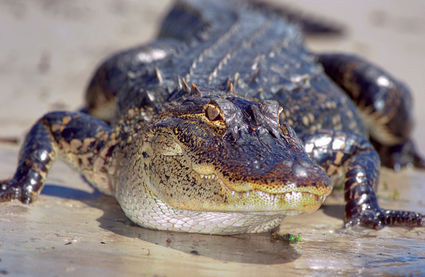Ike takes bite out of local gator population
Last updated 7/29/2009 at Noon
Hurricane Ike, more than 10 months ago, has taken a bite out of alligator populations in the coastal marshes along the upper Texas Gulf Coast. Researchers conducting aerial surveys of alligator nesting activity in Orange County wetlands found the reptiles and their habitat are struggling to rebound.
According to wildlife officials, nesting activity in Orange, Jefferson and Chambers counties, the most abundant in Texas, are barely 10 percent the number of gator nests they saw a year ago.
The Texas Parks and Wildlife Department monitors the Texas alligator population via aerial nest surveys and night time “spotlight” counts.
“The numbers were down 90 percent,” said biologist Amos Cooper, who heads the Texas Parks and Wildlife Department’s Alligator Program based at the J.D. Murphy WMA in Jefferson County.
Biologists counted 24 alligator nests in the three counties during the June-July survey. Normally the researchers find about 200 nest in the same areas.
The survey included the 7,998 acre Lower Neches WMA located near Bridge City. The WMA extends south about eight miles southwest of Orange and borders Sabine Lake on the east side. Studies also included the Tony Houseman WMA in Orange.
Hurricane Ike shoved a wall of high-salinity Gulf water as far as 15-miles inland from Galveston Bay to the Louisiana border. The initial surge killed an undetermined number of gators, mostly by drowning.
Others have died from delayed mortality. The saltwater killed much of the vegetation and forage base on which alligators depend. Recent rains, however, may help improve the plight of the alligator by helping purge the marsh of the saltwater by “flushing.”
Hurricane Ike was followed by a dry autumn and winter. Orange County was under a burn ban and in near draught conditions until last week.
Lack of nutrition combined with dehydration from ingesting saltwater eventually kills the semi-aquatic, armored reptile that is related to crocodiles and native to the U.S.
“Lots of little gators were lost; they’re the ones most vulnerable,” Cooper said. Baby alligators must feed themselves. They eat minnows, crayfish, snails, insects and tadpoles. Bridge City residents found numerous alligator hatchlings in grassy debris from the marsh the storm had pushed into neighborhoods. Large reptiles were also found.
Alligators displaced from their traditional feeding and breeding grounds have been forced to adapt in smaller pockets of habitable pools and vegetation. Competition and cannibalism, the species’ instinct to regulate over-population, claimed many of the smaller alligators.
Despite the losses from Ike, the alligator population in southeast Texas remains strong, TPWD officials say. While a lot of small and mid-size alligators may have been lost, many larger gators survived and are drifting back into their traditional range as conditions improve. Formerly an endangered species, the alligator is now a protected game animal in Texas. Special permits are required to hunt, raise, or possess alligators.
TPWD officials feel the alligator population in the hurricane-impacted area remains healthy enough to allow limited harvest during the Sept. 10-30 alligator hunting season. However, officials are reducing the number of permits they’ll offer to prospective alligator hunters through a drawing of applications.
Prior to Ike, it was estimated that about 350,000 alligators lived in the marshes, swamps and wetlands of a 22-county area along the length of the Texas coast. Orange, Jefferson, Chambers and Galveston counties held an estimated 250,000 of those alligators.
March 1-May 30 is the peak time for breeding and nesting. Typically, 80 percent or more of alligator nests are built by June 15. Females typically lay over 35 eggs. Each egg is about 3 inches long. The eggs incubate for about 2 months, and the female will watch and defend the nest during this time.
The story of the American alligator is one of both drastic decline and successful recovery, a story of state and federal cooperation, and truly one of the prominent success stories of the nation’s endangered species program.














Reader Comments(0)